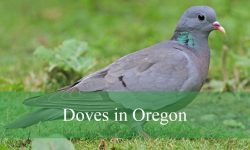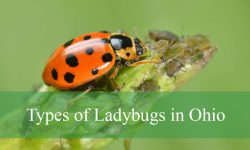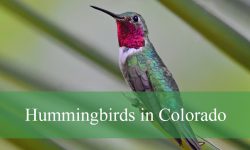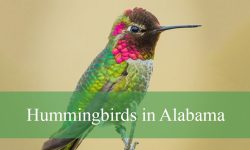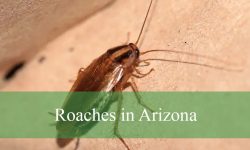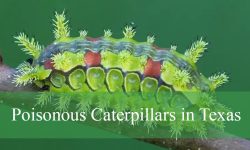The waterways and lowlands of Oklahoma host a rich diversity of frogs whose calls resonate through meadows and forested edges each evening. These amphibians bring life to the state’s warm evenings, signaling the arrival of spring and the rhythm of rain-soaked seasons.
Each region of the state supports its own unique species—plains echo with the calls of leopard frogs, while the wooded wetlands of the east host colorful treefrogs perched among the leaves. From the powerful American Bullfrog to the delicate Spring Peeper, Oklahoma’s frogs thrive across a remarkable range of habitats.
Observing these creatures offers a glimpse into the health of the environment and the beauty of natural soundscapes. With patience, a flashlight, and a careful step through the marsh, one can witness some of the most vocal and vibrant wildlife the state has to offer.
Common Types of Frogs Found in Oklahoma
American Bullfrog (Lithobates catesbeianus)
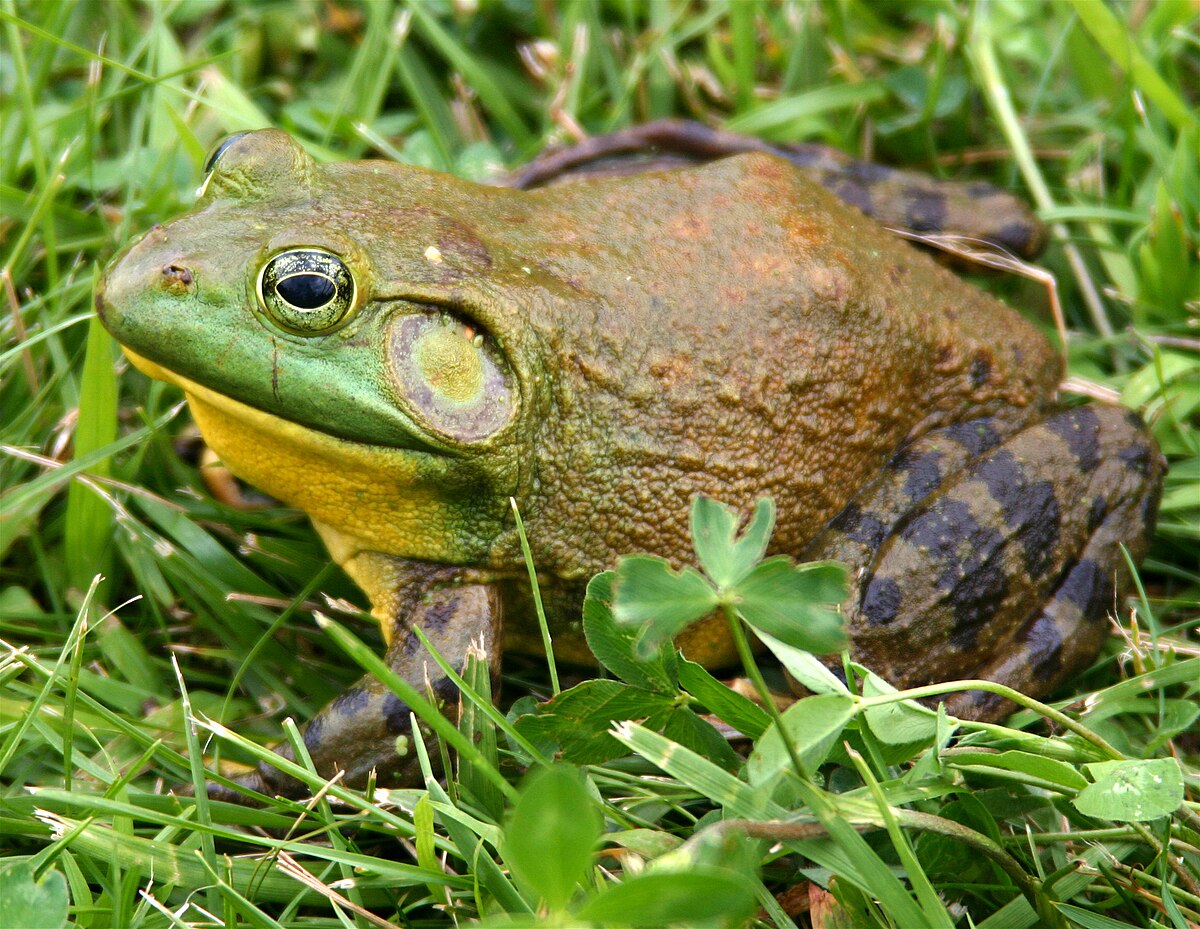
The American Bullfrog is the largest native frog species in Oklahoma, easily recognized by its deep, resonant “jug-o-rum” call that can carry over long distances during warm summer nights. Adults typically measure between 3.5 and 6 inches in length, with robust, muscular bodies and smooth olive-green skin often marked with darker mottling. Their large tympanum (eardrum) is a key identifying feature—particularly prominent in males, where it appears larger than the eye. The powerful hind legs are well adapted for swimming and leaping, allowing the bullfrog to move quickly through water and along muddy banks.
Bullfrogs are found across most of Oklahoma, favoring permanent freshwater habitats such as lakes, ponds, slow-moving rivers, and reservoirs. They prefer areas with abundant vegetation along the edges, providing both cover and access to food. This species is highly aquatic, spending most of its life in or near water, and is active mainly at night when humidity is higher and temperatures are moderate.
As opportunistic predators, American Bullfrogs consume a wide range of prey including insects, spiders, crayfish, small fish, and even other frogs. They use a sit-and-wait hunting strategy, ambushing anything that fits into their wide mouths. Their ability to exploit various food sources contributes to their success in diverse environments across Oklahoma. Bullfrogs are particularly common in central and eastern parts of the state, where wetlands and stable water bodies are abundant.
Green Frog (Lithobates clamitans)
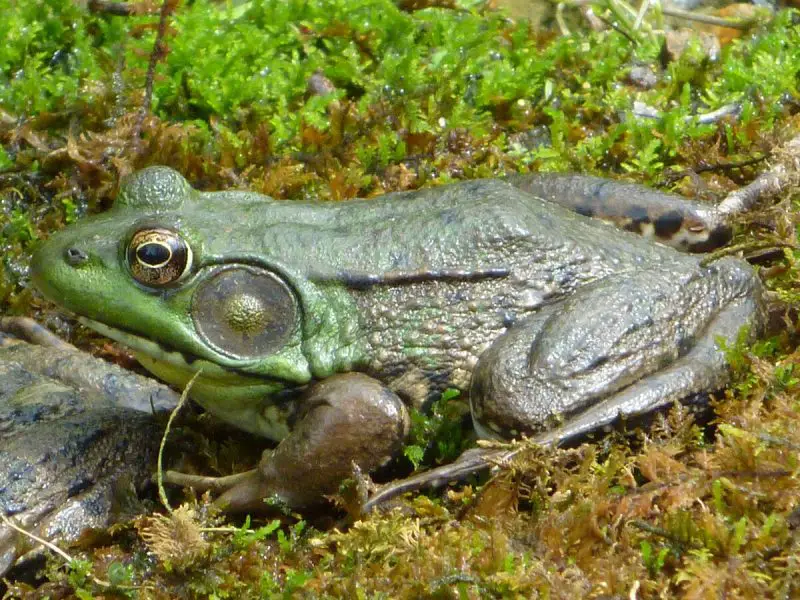
The Green Frog is slightly smaller than the bullfrog, reaching about 2.5 to 4 inches in length, and is known for its distinct, twang-like call that resembles the plucking of a loose banjo string. Its coloration ranges from bright green to bronze or brownish tones, often with small dark spots scattered across its back. A key identifying feature is the prominent dorsolateral ridge—a fold of skin that runs from the eye down the sides of the back, unlike the bullfrog, which lacks this ridge. The tympanum is visible but proportionally smaller, helping distinguish it from its larger cousin.
In Oklahoma, Green Frogs are found mainly in the eastern and southeastern regions, where forests and swamps are more common. They inhabit ponds, lakes, marshes, and shaded stream edges, often preferring cooler and more vegetated waters. During the day, they can be seen basking near the shoreline, leaping into the water when approached. At night, males gather to call during the breeding season, which typically extends from late spring into midsummer.
Green Frogs are carnivorous, feeding primarily on insects, small crustaceans, and other invertebrates. Their long, sticky tongues make them efficient hunters of flying or crawling prey. In turn, they are an essential food source for herons, snakes, and raccoons. Their presence in Oklahoma’s ecosystems signals healthy wetland conditions, as they are sensitive to pollution and water quality changes.
Southern Leopard Frog (Lithobates sphenocephalus)
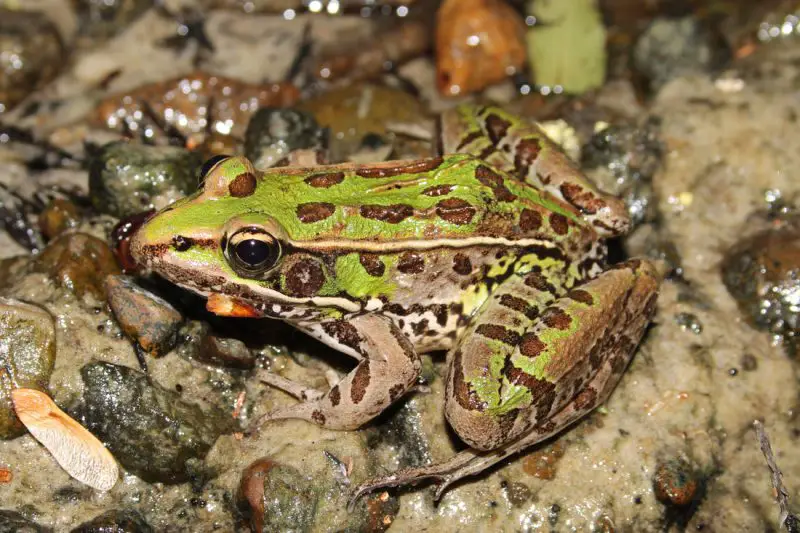
The Southern Leopard Frog is one of Oklahoma’s most visually striking amphibians, named for the bold dark spots scattered across its light brown or green body. Adults measure about 2 to 3.5 inches long, with slender bodies, long legs, and a light-colored ridge running along each side of the back. The snout is pointed, and the species often has a distinct white spot in the center of the tympanum. Its call—a rapid, chuckling sound—is a familiar chorus in spring wetlands and flooded meadows.
These frogs are widespread throughout eastern and central Oklahoma, favoring marshes, ponds, ditches, and temporary pools that appear after heavy rains. Unlike more aquatic species, Southern Leopard Frogs are often found a short distance from water, especially after rainfall. They are strong jumpers and quick movers, making them difficult to capture or observe up close. Breeding begins early in the year, often in February or March, when males gather in shallow water to call.
Southern Leopard Frogs feed primarily on insects such as beetles, crickets, and flies, but they will also consume small crustaceans and worms. Their active, mobile lifestyle makes them effective hunters both day and night. During dry seasons, they may burrow into moist soil or hide under vegetation to avoid dehydration. Their adaptability to various aquatic environments allows them to thrive across much of Oklahoma’s diverse landscape.
Plains Leopard Frog (Lithobates blairi)
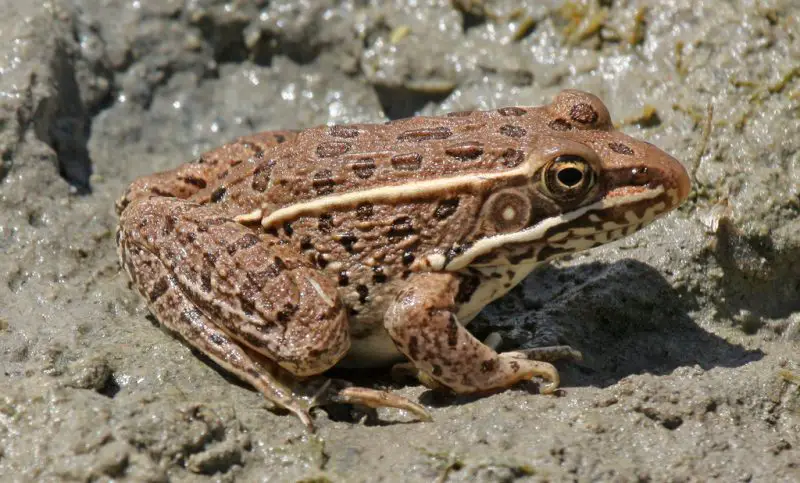
The Plains Leopard Frog closely resembles the Southern Leopard Frog but can be distinguished by a lighter spot in the center of the body and a broken dorsolateral fold just behind the eardrum. Adults measure between 2 and 3.5 inches in length and have a tan or light brown coloration with numerous dark spots arranged in irregular rows. Their long legs and sleek bodies make them agile jumpers, capable of quick, powerful leaps to escape predators. The species’ call is a series of short, low-pitched chuckles or clucks, often heard after spring and summer rains.
This species is common across central and western Oklahoma, favoring open habitats such as prairie ponds, cattle tanks, irrigation ditches, and temporary rainwater pools. It is well adapted to drier environments compared to other frogs, often breeding in ephemeral wetlands that fill during the rainy season. Plains Leopard Frogs are primarily nocturnal, spending daylight hours hidden under vegetation or in muddy burrows to avoid desiccation.
Their diet consists mainly of insects and small invertebrates, including grasshoppers, crickets, spiders, and worms. They play a vital ecological role in controlling pest populations in agricultural and prairie ecosystems. In turn, they serve as prey for birds, snakes, and mammals. Their ability to survive in semi-arid conditions and to utilize temporary water sources makes the Plains Leopard Frog one of the most resilient amphibians native to Oklahoma’s grasslands.
Pickerel Frog (Lithobates palustris)
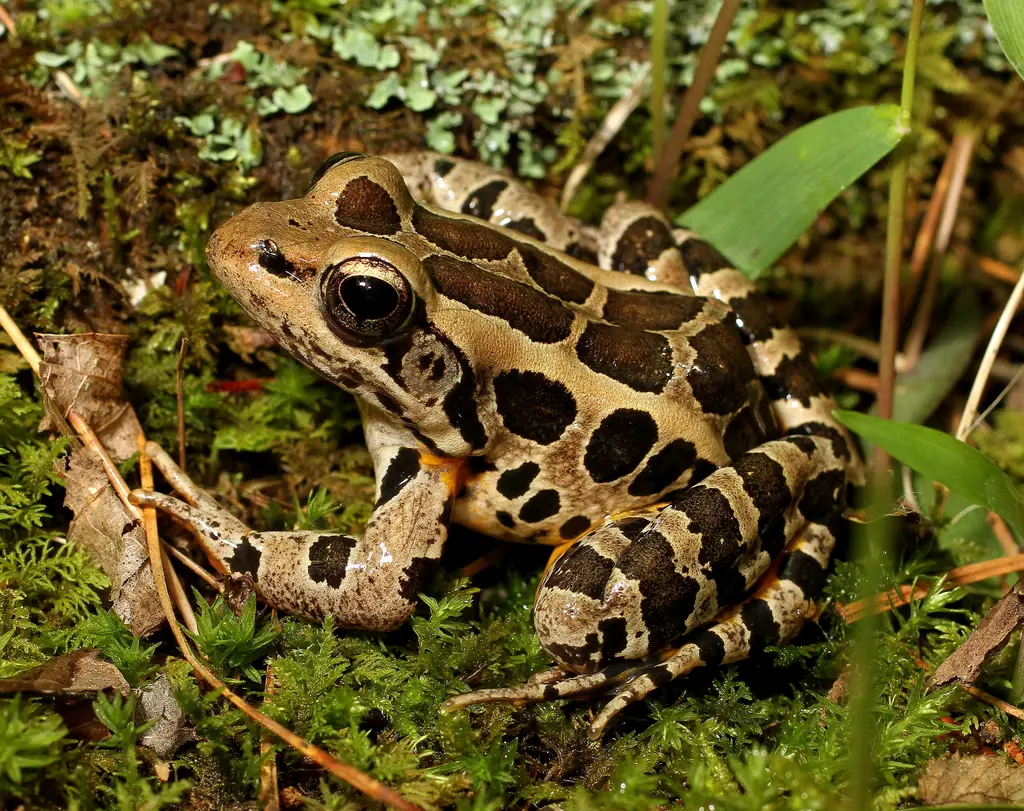
The Pickerel Frog is one of the more distinctive frog species in Oklahoma, recognized by its neatly arranged, rectangular dark spots running in two parallel rows down its back. Adults typically reach 2 to 3 inches in length and have smooth, tan to light brown skin with a yellow or orange flush on the inner thighs—visible when the frog leaps. The snout is fairly pointed, and the dorsolateral ridges are clearly defined. Its call is a low, snore-like sound lasting a few seconds, often heard in early spring near cool, clear water.
In Oklahoma, the Pickerel Frog is primarily found in the eastern and northeastern parts of the state, where the climate is cooler and moist habitats are more common. They prefer clean streams, spring-fed ponds, and shaded wetlands, avoiding stagnant or polluted waters. Their preference for high-quality aquatic habitats makes them a good indicator species for water purity. During the breeding season, they congregate in shallow, slow-moving waters, and later disperse into nearby meadows or wooded areas.
Pickerel Frogs feed on a variety of insects and invertebrates, including beetles, flies, spiders, and worms. Unlike many other frogs, they secrete mild toxins through their skin that can deter some predators such as snakes or mammals. However, they are still preyed upon by birds and larger amphibians. Their selective habitat and sensitivity to pollution mean they are less common than other frogs in Oklahoma, but where found, they play an important role in maintaining ecological balance.
Crawfish Frog (Lithobates areolatus)
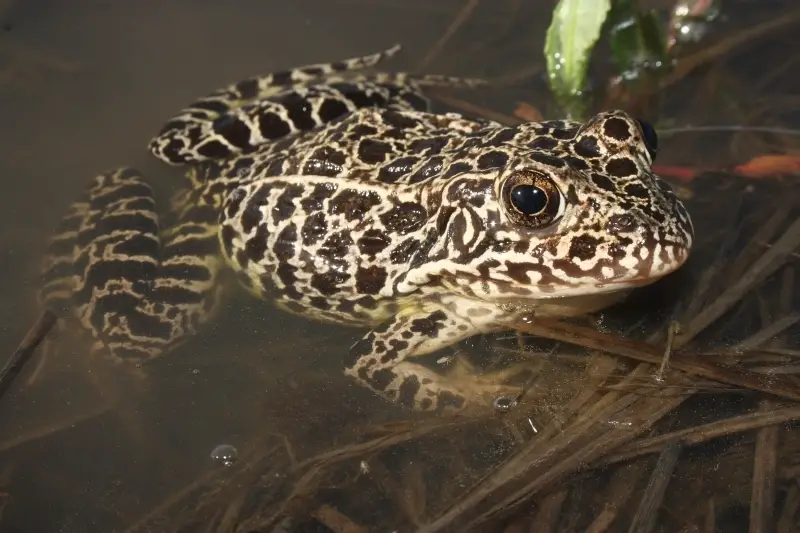
The Crawfish Frog is one of Oklahoma’s most unique and localized frog species, named for its close association with crayfish burrows that it uses for shelter. Adults typically measure between 2.5 and 4 inches long and have a stout body covered with large, dark, rounded spots outlined in light borders across a yellowish or tan background. The belly is white, and the skin appears slightly granular. Its deep, resonant snore-like call can be heard echoing across grasslands and prairies during early spring nights after heavy rains.
Crawfish Frogs inhabit open grasslands, pastures, and prairies across central and eastern Oklahoma, particularly in areas with abundant crayfish burrows. They spend most of the year underground within these burrows, emerging mainly during the breeding season, which usually occurs from March to April. Because of this secretive behavior, they are rarely seen outside of rainy periods. The burrows provide both refuge and moisture, allowing them to survive the state’s dry summers.
Their diet consists mainly of insects, spiders, and other small invertebrates they encounter during nighttime foraging near the mouths of their burrows. Crawfish Frogs are considered an important part of the prairie ecosystem, controlling insect populations and serving as prey for snakes and birds. Unfortunately, their populations have declined in some regions due to habitat loss, agricultural development, and wetland drainage. Conservation efforts in Oklahoma focus on preserving native grasslands and maintaining healthy crayfish populations essential for their survival.
Wood Frog (Lithobates sylvaticus)
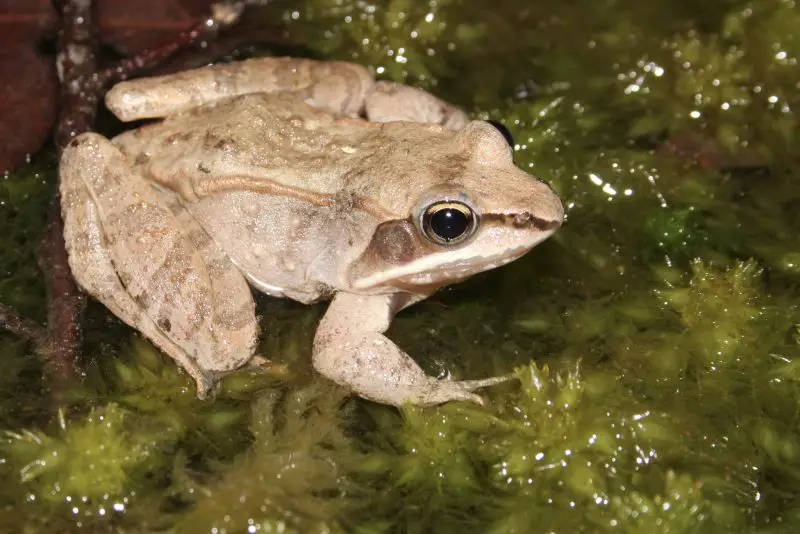
The Wood Frog is a rare and fascinating species in Oklahoma, known for its ability to survive extremely cold conditions further north. Adults are modest in size, typically measuring 1.5 to 3 inches long, with smooth skin that ranges in color from tan to reddish-brown. A distinctive dark “mask” extends from each eye to the base of the forelimbs, giving it a unique and easily recognizable appearance. The dorsolateral ridges are prominent, and the underside is pale with a light yellow wash. Its call resembles a rapid series of quacks, often compared to the sound of a duck.
In Oklahoma, Wood Frogs are only found in the far northeastern part of the state, near forested areas bordering Missouri and Arkansas. They prefer cool, shaded woodland habitats with temporary pools or small streams used for breeding. During early spring, they are among the first frogs to emerge and reproduce—often when snow or frost still lingers. After breeding, they move into moist forests where they remain hidden under leaf litter and fallen logs.
Wood Frogs primarily feed on insects, worms, and small invertebrates found within the forest floor. What makes them remarkable is their physiological adaptation: during winter, they can survive freezing temperatures by entering a state of suspended animation, with ice forming inside their bodies without causing damage. Although rare in Oklahoma, their presence highlights the diversity of amphibian life at the edge of the state’s temperate forest zones.
Northern Cricket Frog (Acris crepitans)
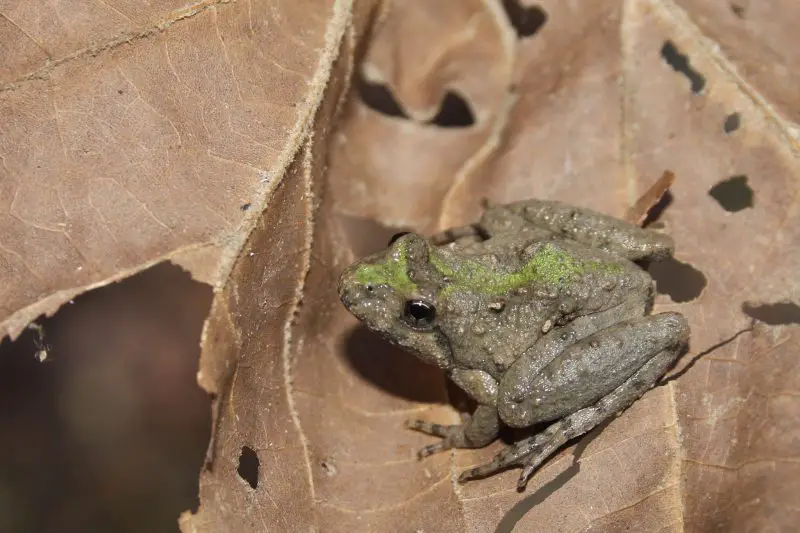
The Northern Cricket Frog is one of Oklahoma’s smallest native frogs, rarely exceeding 1.5 inches in length. It is easily recognized by its rough, warty skin, which ranges in color from grayish-green to brown, often marked with a dark triangle between the eyes and a faint dorsal stripe. Despite its tiny size, it has powerful legs capable of impressive leaps. The call of this species resembles the rapid clicking of two small pebbles tapped together, earning it the “cricket frog” name.
This species is widespread across most of Oklahoma, thriving in habitats near ponds, lakes, slow-moving streams, and even roadside ditches. They prefer open, sunny areas with low vegetation and are often found sitting along muddy or sandy shorelines. Northern Cricket Frogs are highly active during the day and tend to leap into the water at the slightest disturbance. Breeding typically occurs in late spring through summer, and males can be heard calling during warm, humid evenings.
Their diet consists mainly of small insects such as ants, flies, and mosquitoes, making them beneficial for pest control. They also consume small spiders and aquatic invertebrates. Due to their sensitivity to pollutants and habitat degradation, healthy populations of Northern Cricket Frogs often indicate clean, balanced ecosystems. In Oklahoma, they are one of the most commonly encountered frogs during the warmer months, particularly in agricultural and prairie wetlands.
Blanchard’s Cricket Frog (Acris blanchardi)
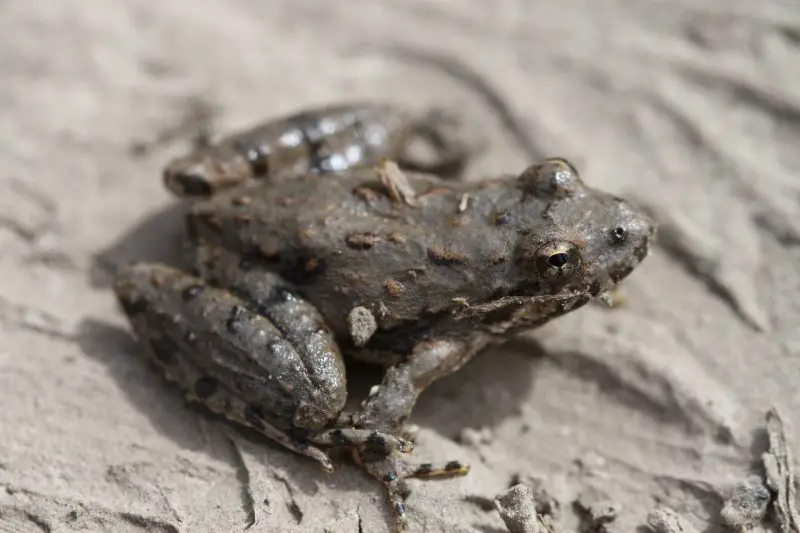
Blanchard’s Cricket Frog closely resembles the Northern Cricket Frog but tends to have a slightly more robust build and a broader snout. Adults range between 0.6 and 1.5 inches long, featuring variable color patterns that can include green, gray, brown, or reddish tones with irregular stripes or blotches. Like its relative, it has warty skin and a distinct triangular mark between the eyes. Its call is a fast, metallic series of clicks, often compared to a ball bearing bouncing on a tabletop.
This species occurs throughout much of Oklahoma, particularly in the eastern and central regions, where it occupies marshes, grassy pond edges, and flooded fields. It is especially abundant in habitats with shallow water and sparse vegetation, where it can bask and hunt for prey. Blanchard’s Cricket Frog is known for its remarkable jumping ability and erratic movements, which make it difficult for predators to capture. It is more terrestrial than many other frogs, sometimes found far from permanent water.
Blanchard’s Cricket Frogs feed on a variety of tiny arthropods, including small beetles, flies, and mosquitoes. They play an important role in controlling insect populations near wetlands. Though small and often overlooked, they are highly adaptable and can thrive in temporary ponds created by summer rains. However, habitat loss and pesticide use have caused localized declines in some parts of Oklahoma.
Spring Peeper (Pseudacris crucifer)
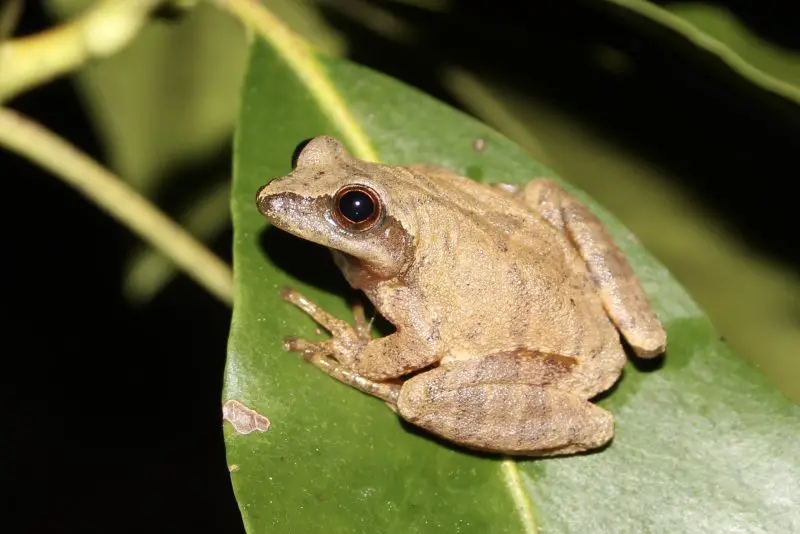
The Spring Peeper is one of the earliest signs of spring in eastern Oklahoma, famous for its high-pitched “peep-peep” calls that fill the air during late February and March nights. These tiny frogs measure about 1 to 1.5 inches long and have smooth, moist skin that varies in color from tan to grayish-brown. A dark “X” pattern on their back is a key identifying feature, along with slightly expanded toe pads that help them cling to vegetation. Despite their small size, their loud choruses can be heard from great distances.
In Oklahoma, Spring Peepers inhabit the moist woodlands and forested wetlands of the eastern counties. They prefer shallow ponds, flooded meadows, and temporary pools for breeding, particularly in areas shaded by trees. After the breeding season, they move into wooded areas where they spend much of their time hidden under leaf litter and fallen branches. Their secretive nature makes them more often heard than seen.
Their diet mainly includes small insects, ants, spiders, and other invertebrates they catch with their sticky tongues. As one of the earliest breeding frogs, Spring Peepers play a key role in spring ecosystems, consuming insects that emerge after winter. Their presence marks the start of the amphibian breeding season in Oklahoma’s eastern woodlands.
Boreal Chorus Frog (Pseudacris maculata)
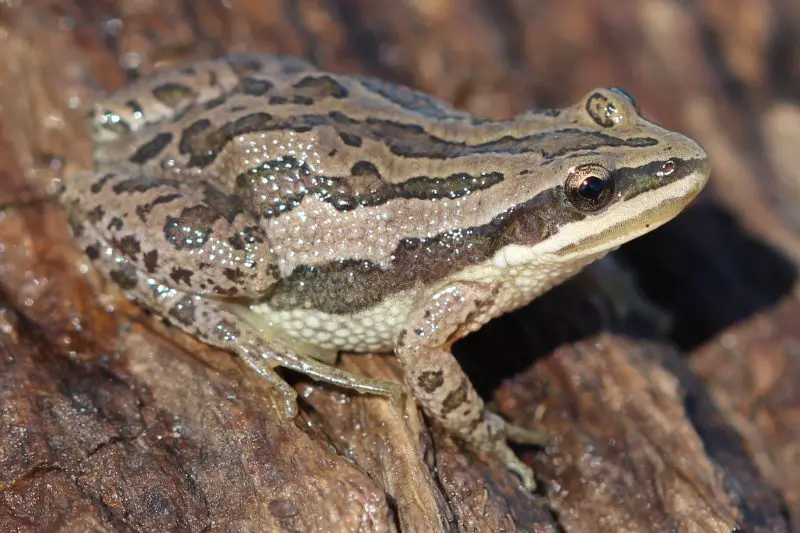
The Boreal Chorus Frog is a small and hardy species, usually measuring just over 1 inch in length. Its coloration ranges from brown to olive with three dark stripes or rows of spots running down the back. The skin is smooth, and the frog has a pointed snout with a faint line running from the nose through the eye. Its call is a distinctive, rising trill that sounds like running a fingernail along the teeth of a comb, and it can be heard echoing through wetlands in early spring.
In Oklahoma, this species is found mainly in the northern and northwestern parts of the state, where the terrain transitions into open prairies and grasslands. It breeds in shallow pools, ditches, and flooded pastures, often before most other frogs have emerged. After the breeding season, Boreal Chorus Frogs disperse into nearby fields and grassy areas where they remain hidden in moist soil or under vegetation. Their adaptability to cooler climates allows them to thrive in regions with shorter wet seasons.
Boreal Chorus Frogs feed primarily on small insects such as flies, gnats, and beetles, contributing to natural pest control. Their early breeding cycle makes them an important food source for birds and aquatic predators emerging from winter dormancy. Although not as abundant as southern species, they remain an essential part of Oklahoma’s northern prairie ecosystems.
Cajun Chorus Frog (Pseudacris fouquettei)
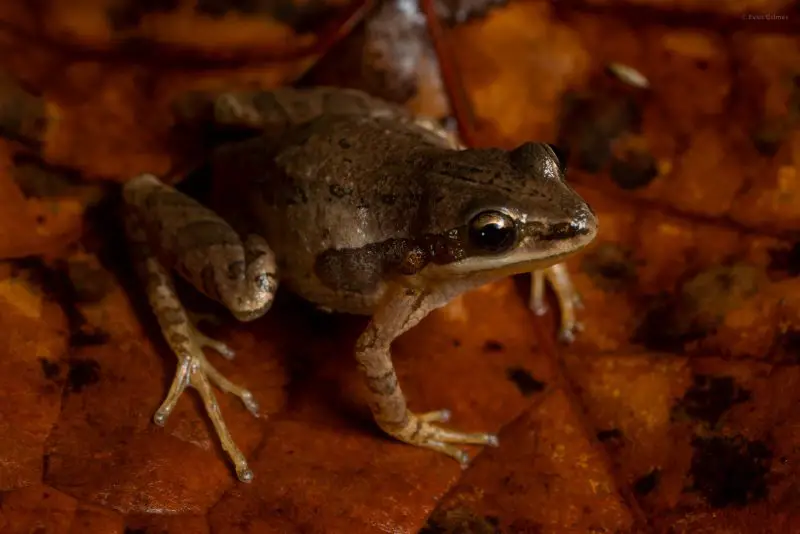
The Cajun Chorus Frog is a small, slender species that closely resembles other chorus frogs but can be identified by its distinct call—a rapid, metallic “creeek-creeek-creeek” that often begins in late winter. Adults reach around 1 to 1.5 inches long and have smooth skin with brown or gray coloring and three dark stripes along the back. The underside is pale, and the snout is slightly rounded. This species was once grouped with the Upland Chorus Frog but is now recognized as distinct based on genetic and vocal differences.
In Oklahoma, Cajun Chorus Frogs are found mostly in the southeastern and central parts of the state, inhabiting temporary pools, flooded grasslands, and woodland edges. They are among the first frogs to start calling each year, sometimes even before the last frost melts. Breeding occurs in shallow, fishless water bodies, where males gather in large choruses during rainy nights. After breeding, they retreat into grassy or wooded areas to feed and rest through the warmer months.
Their diet consists mainly of small flying insects, gnats, and ants. Cajun Chorus Frogs are highly adaptive and can survive in fluctuating environments, from forested wetlands to roadside ditches. They serve as an important indicator of seasonal changes and are a vital link in local food webs, both as insect predators and prey for birds, snakes, and small mammals.
Upland Chorus Frog (Pseudacris feriarum)
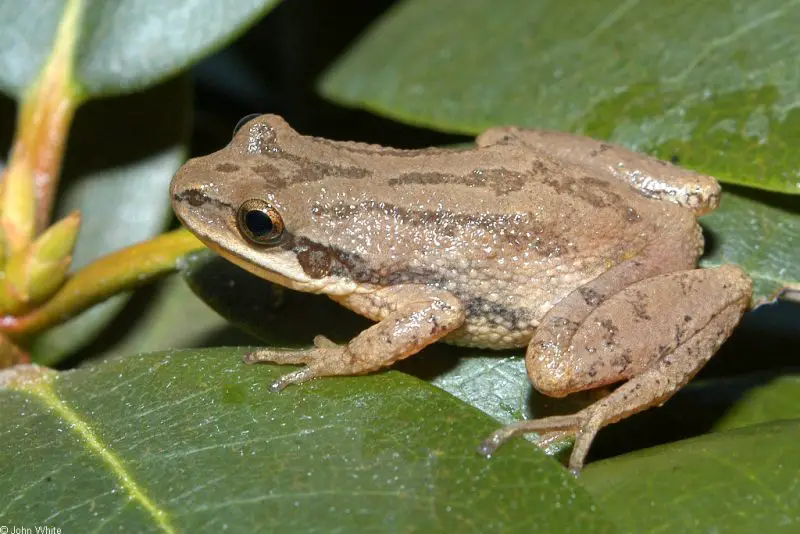
The Upland Chorus Frog is a small and secretive species, usually measuring around 1 to 1.5 inches in length. Its coloration ranges from light brown to gray with three faint dark stripes or rows of spots running along its back. A dark line extends from the snout through the eye to the shoulder, and the belly is white with occasional mottling. Its call—a rising “crrreeeeek” that resembles running a thumb over a small comb—is one of the first frog sounds heard in late winter or early spring across Oklahoma.
In Oklahoma, the Upland Chorus Frog is found mostly in the eastern and central regions, where it inhabits grassy fields, woodland edges, and shallow pools that form after rain. It prefers temporary wetlands without fish, where its eggs and tadpoles can develop safely. During dry seasons, it retreats into burrows or hides under vegetation to avoid desiccation. It is most active during rainy, mild nights when males gather to call for mates.
These frogs feed primarily on small insects, spiders, and other invertebrates, using their sticky tongues to capture prey. Their small size and camouflage make them difficult for predators to spot. Although they are abundant in suitable habitats, their populations depend heavily on seasonal rains that create breeding pools. In Oklahoma, their early calls often mark the true beginning of spring in rural and wooded areas.
Strecker’s Chorus Frog (Pseudacris streckeri)
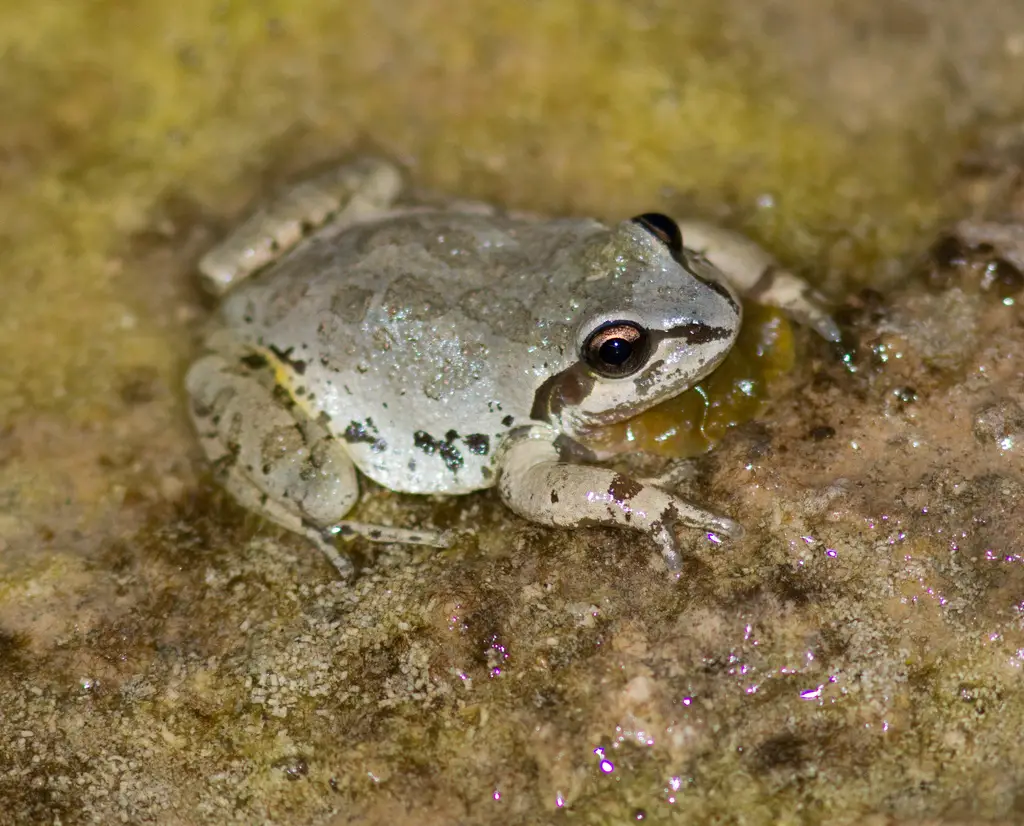
Strecker’s Chorus Frog is a hardy and adaptable species native to the southern Great Plains. Adults grow to about 1.5 inches in length and have rough, granular skin that ranges in color from light gray to tan or olive, often with irregular dark blotches. The body is stocky, and a dark stripe runs from the snout through the eye to the side of the body. Its call is a short, harsh “waahk” sound, repeated in rapid succession during breeding season.
In Oklahoma, Strecker’s Chorus Frog is widespread in the southern, central, and western parts of the state, thriving in grasslands, agricultural fields, and open woodlands. It breeds in shallow, temporary pools that appear after heavy spring rains and is known for being one of the first frogs to call during mild winter nights. Outside the breeding season, it spends most of its time underground or hidden in cracks in the soil to escape heat and drought.
Strecker’s Chorus Frogs are nocturnal insectivores, feeding on small invertebrates like ants, beetles, and flies. Their adaptability allows them to survive in regions with variable rainfall and limited permanent water. Despite their small size, they play an important role in controlling insect populations and serve as food for snakes, birds, and mammals. In Oklahoma, their distinctive calls often echo across fields on warm, rainy evenings.
Gray Treefrog (Dryophytes versicolor)
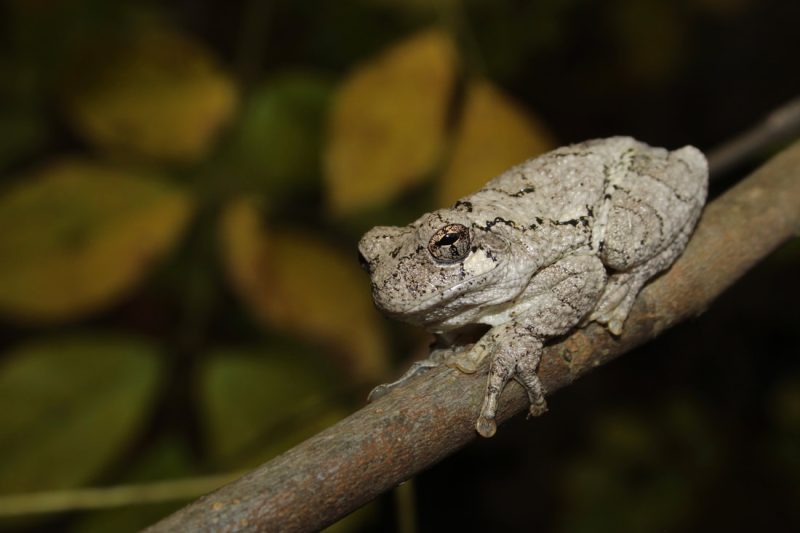
The Gray Treefrog is a beautiful and highly variable species, capable of changing its skin color from gray to green depending on temperature and surroundings. Adults grow to about 1.5 to 2 inches in length and have a distinctive granular texture with irregular blotches on their backs. The most reliable way to identify this species is by the bright yellow or orange patches on the inner thighs, visible when they jump. Their call is a slow, musical trill lasting a few seconds, often heard on humid nights in late spring and summer.
In Oklahoma, Gray Treefrogs inhabit the eastern and northeastern forests, where they are often found high in trees or clinging to shrubs near ponds and woodland pools. They are excellent climbers, aided by large, adhesive toe pads that allow them to cling to bark, leaves, and even glass. During the day, they rest in shaded spots or cavities, becoming active after dusk. Breeding occurs in late spring, and males call from trees or vegetation near still water.
Their diet consists of small insects, moths, spiders, and other invertebrates they capture with their sticky tongues. Gray Treefrogs are well adapted to temperate climates and can survive brief freezes by producing natural antifreeze compounds in their bodies. In Oklahoma’s wooded regions, their calls are a familiar part of the summer night chorus.
Cope’s Gray Treefrog (Dryophytes chrysoscelis)
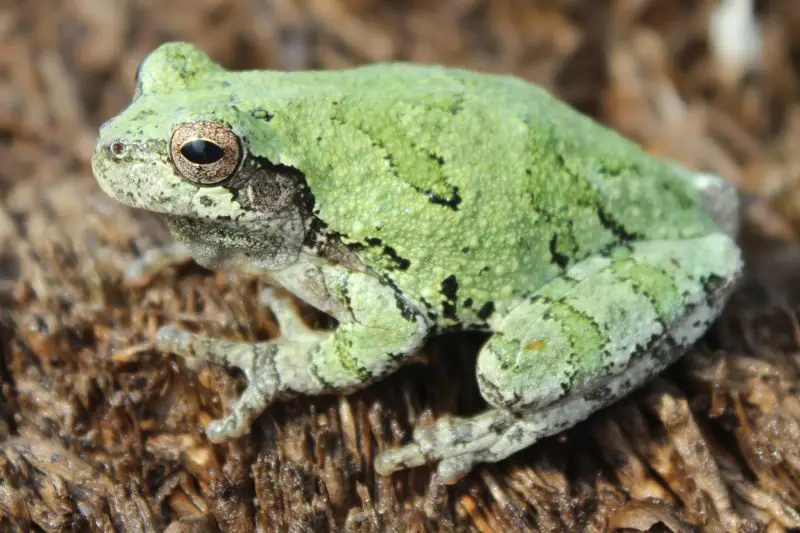
Cope’s Gray Treefrog is nearly identical in appearance to the Gray Treefrog, and distinguishing the two visually is extremely difficult. Both have similar size, coloration, and bright yellow inner thighs. The key difference lies in their calls—Cope’s Gray Treefrog produces a faster, more rapid trill compared to the slower call of D. versicolor. Adults typically measure between 1.25 and 2 inches long and have rough skin with irregular blotches and a well-developed adhesive pad on each toe for climbing.
This species is widespread across central and eastern Oklahoma, thriving in wooded areas, suburban gardens, and wetlands surrounded by trees. It spends much of its time in shrubs or tree branches, descending at night to feed or breed. During the breeding season, which occurs from late April through July, males call loudly near ponds and ditches after rains. They are often more abundant than D. versicolor in warmer and more open regions.
Cope’s Gray Treefrogs feed on insects such as moths, beetles, and crickets. They are skilled hunters, using stealth and quick reflexes to catch prey. Their ability to tolerate both urban and rural habitats allows them to persist in many parts of Oklahoma. Although visually indistinguishable from the Gray Treefrog, their faster call is a reliable clue for identification during the breeding season.
Green Treefrog (Dryophytes cinereus)
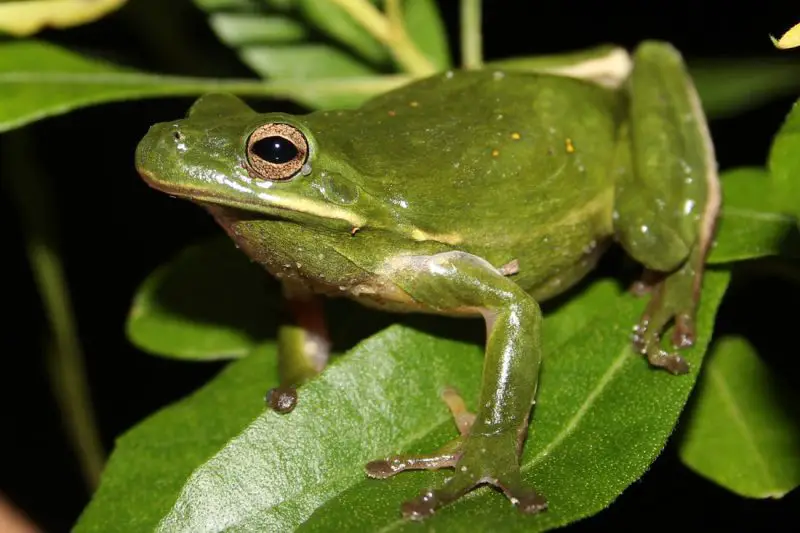
The Green Treefrog is one of the most visually striking frogs in Oklahoma, known for its smooth, bright green skin and slender body. Adults usually measure 1.5 to 2.5 inches long and often display a distinct white or yellowish stripe running from the upper lip down the sides of the body. Their large eyes and long limbs give them a graceful, alert appearance. The call is a loud, nasal “quank-quank-quank,” which can be heard from great distances on humid summer nights.
In Oklahoma, Green Treefrogs are mostly found in the southeastern and eastern parts of the state, where warm, humid environments support their populations. They inhabit swamps, ponds, marshes, and areas with abundant emergent vegetation such as cattails and reeds. These frogs are excellent climbers and are often seen perched on tall grasses or plant stems near water. They become most active at night, especially during the breeding season, which peaks in early summer.
Their diet consists mainly of small flying insects such as flies, mosquitoes, and moths, which they catch with quick flicks of their tongues. Green Treefrogs are important for insect control and are a favorite among wildlife enthusiasts due to their bright color and cheerful calls. In Oklahoma, they are most frequently encountered after rainfall or during warm, damp evenings in lowland wetland regions.
Bird-voiced Treefrog (Dryophytes avivoca)
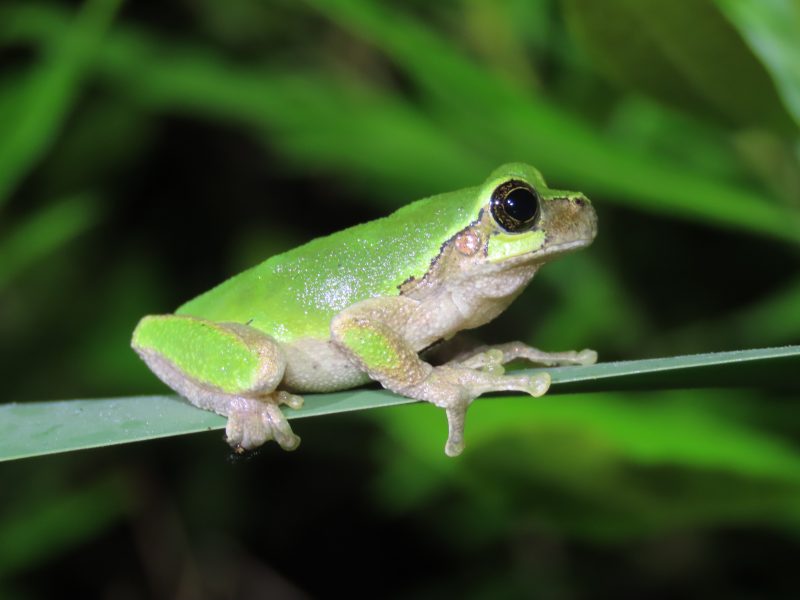
The Bird-voiced Treefrog is a secretive and well-camouflaged species, named for its distinctive birdlike call—a high-pitched, whistling “weet-weet-weet.” Adults reach about 1.5 inches in length and have smooth gray or greenish-gray skin patterned with darker blotches. Like other treefrogs, they have large toe pads for climbing and bright yellow or greenish patches on the inner thighs. Their coloration helps them blend seamlessly into tree bark and foliage.
In Oklahoma, the Bird-voiced Treefrog is restricted to the far southeastern corner of the state, particularly in bottomland hardwood forests and swampy areas along rivers. It prefers mature forests with standing water nearby, such as cypress-tupelo wetlands. Breeding takes place in late spring and early summer, with males calling from vegetation overhanging shallow pools. Outside of the breeding season, these frogs remain high in the canopy, rarely descending to the ground.
They feed primarily on small insects and arthropods, including flies, moths, and beetles. Their excellent camouflage and arboreal habits make them difficult to spot, even in areas where they are common. The presence of Bird-voiced Treefrogs in southeastern Oklahoma highlights the region’s strong ecological connection to the wet, forested environments of the Deep South.
Barking Treefrog (Dryophytes gratiosus)
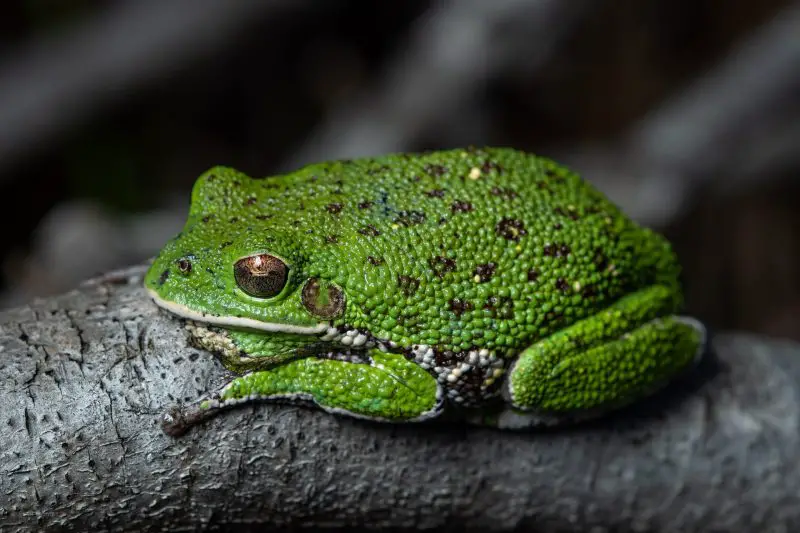
The Barking Treefrog is the largest native treefrog in Oklahoma, growing up to 2.5 inches long. It has smooth, somewhat bumpy green skin that may change shades depending on temperature and humidity, with round darker spots scattered across the back. Its body is stout, and the eyes are large and golden. True to its name, its call is a deep, hollow “bark” that can be heard over long distances on warm summer nights.
In Oklahoma, this species is found mainly in the southeastern counties, inhabiting cypress ponds, swamps, and forested wetlands. It prefers habitats with abundant vegetation where it can climb and hide during the day. Barking Treefrogs are excellent climbers, using their large adhesive toe pads to cling to smooth surfaces. During the breeding season, males gather in temporary pools after heavy rains and call in a rhythmic chorus that resembles barking dogs.
Their diet consists of a variety of insects, including beetles, moths, and crickets, which they hunt actively at night. Barking Treefrogs play an important ecological role in controlling insect populations while serving as prey for snakes and birds. Though their distribution in Oklahoma is limited, they are a cherished species among herpetologists and naturalists for their distinctive calls and impressive size.
Tips for Observing Frogs in Oklahoma
Best Time to See Frogs
The best time to observe frogs in Oklahoma is during the spring and early summer months when most species are active and calling for mates. Breeding typically begins after the first warm rains of late February and continues through July. Warm, humid evenings—especially after thunderstorms—are ideal for frogwatching, as males gather near ponds, ditches, and flooded meadows to sing in chorus. For nocturnal species like the American Bullfrog or the Green Treefrog, bring a flashlight to spot them by their reflective eyes.
Best Places to Find Frogs
Oklahoma’s frogs can be found in a variety of habitats, depending on the species. Eastern Oklahoma is rich in woodlands, swamps, and forested ponds that host treefrogs such as the Cope’s Gray Treefrog and Green Treefrog. Central and western regions are better for grassland and prairie species like the Plains Leopard Frog and Crawfish Frog, which often occupy roadside ditches and temporary rain pools. State parks, wildlife management areas, and nature preserves such as Beavers Bend, Sequoyah, and Red Slough are excellent locations for diverse frog encounters.
Frogwatching Tips
Move quietly and use a dim red or green flashlight to avoid startling frogs while observing. Wearing waterproof boots is useful for exploring shallow ponds and marshy areas at night. Learn to identify species by their unique calls, as many frogs are easier to hear than to see. Avoid touching frogs with bare hands—skin oils or insect repellent can harm their sensitive skin. Finally, respect their habitats by staying on trails and not disturbing breeding sites or egg masses.
FAQs about Frogs in Oklahoma
What is the largest frog in Oklahoma?
The American Bullfrog (Lithobates catesbeianus) is the largest frog species in Oklahoma, often growing up to 6 inches long. It inhabits large ponds, lakes, and slow-moving rivers across the state and is easily recognized by its deep, booming call.
What frog makes the loudest call in Oklahoma?
The Green Treefrog (Dryophytes cinereus) is one of the loudest callers, with its nasal “quank-quank” sound echoing through wetlands on warm summer nights. However, bullfrogs also produce powerful, resonant calls that can carry long distances over water.
When do frogs start calling in Oklahoma?
Most frog species begin calling in late February or early March, right after the first warm rains of the year. Early breeders include Spring Peepers and Chorus Frogs, while larger species such as Bullfrogs and Green Treefrogs call later in the season.
Are there poisonous frogs in Oklahoma?
No native Oklahoma frogs are deadly poisonous. However, Pickerel Frogs produce mild skin toxins that can irritate some predators or humans with sensitive skin. It’s best not to handle frogs unnecessarily.
Do Oklahoma frogs hibernate?
Yes. Most frogs enter a state of dormancy during winter, burrowing into mud, leaf litter, or crayfish burrows to avoid freezing. Some species, such as the Wood Frog, can even survive partial freezing by producing natural antifreeze in their bodies.
What do frogs eat in Oklahoma?
Frogs are carnivorous and feed primarily on insects, worms, spiders, and small invertebrates. Larger species like the American Bullfrog may also eat crayfish, small fish, or even other frogs. They play an essential role in controlling insect populations statewide.
Can you keep wild frogs as pets in Oklahoma?
It’s not recommended to collect wild frogs, as many species are protected or sensitive to habitat disturbance. Instead, observe them in their natural environments or choose captive-bred frogs from reputable sources if you want to keep one as a pet.
Why are frogs important to Oklahoma’s ecosystems?
Frogs are key indicators of environmental health, as they rely on clean water and balanced ecosystems to survive. They help control insect populations and serve as food for birds, snakes, and mammals. Their decline often signals pollution or habitat loss.

